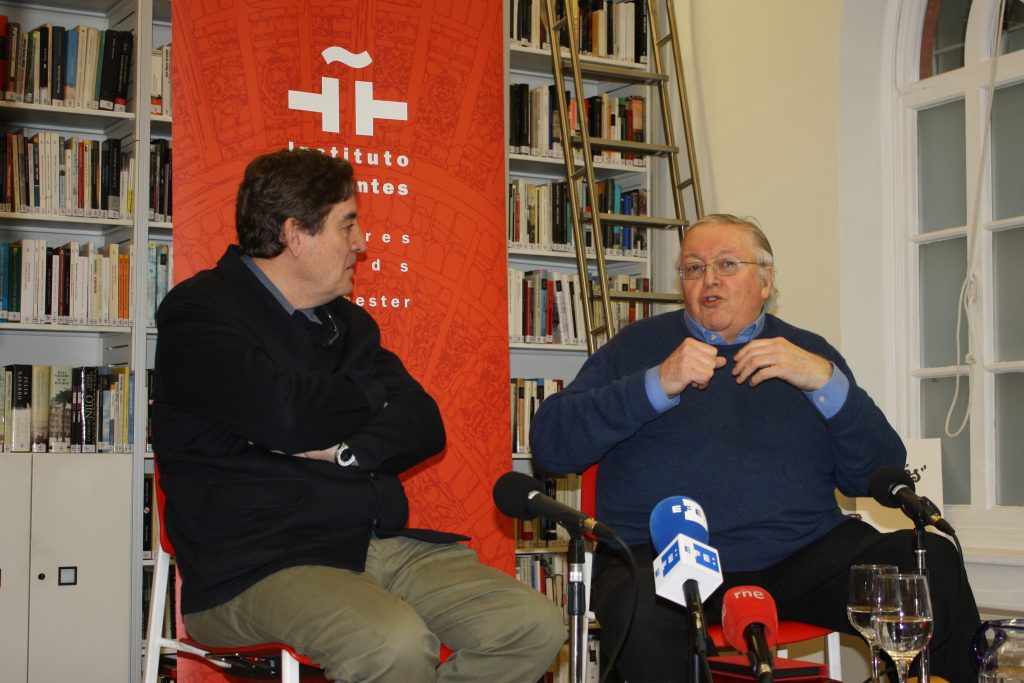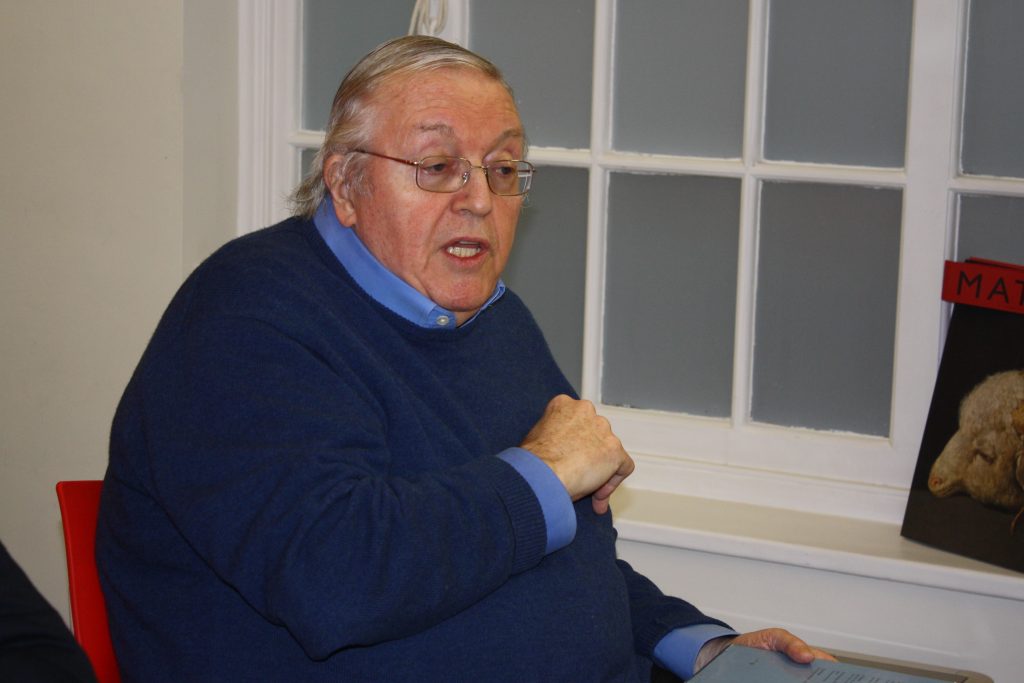Spain recognises the work of the great British historian, Paul Preston

The British historian and Hispanist Sir Paul Preston (Liverpool, 1946) will make an announcement in London on February 28th, that he has chosen to leave a copy of the first book he published in the Caja de las Letras, Instituto Cervantes’ headquarters in Madrid.
The Caja de las Letras is a vault of safe-deposit boxes in a former bank building that has been repurposed as a time capsule for Hispanic culture. Many Spanish artists and thinkers have been invited to leave an artifact of their choosing in the security boxes, along with the date the safe should be reopened.
In the case of Sir Paul Preston, he has chosen a book based on his thesis, The Destruction of Democracy in Spain (1978) which contains notes written by Hispanist Sir Raymond Carr. The first box ever used was Number 1,000 and was filled by writer Francisco Ayala in 2007. And for the first time in the history of the boxes, Preston’s donation is going to be done away from Madrid.
As Sir Paul Preston suffers from specific health problems that prevent him from travelling to Spain, his donated book will be taken to Madrid in a red briefcase guarded by the director of Instituto Cervantes, Luis García Montero.
«It is a great honor to join the Caja de las Letras, especially when it seems that there are very few writers who are not Spanish-speaking, and that has moved me,» said the British historian, who chose to open his box in five years time.
The text, a documented study that traces the origins of the Spanish Civil War, was started from the doctoral thesis that he presented at the University of Oxford about the monarchical conspiracies against the Spanish Republic. It is a copy much valued by Sir Paul Preston because of the annotations from his teacher, British historian and Hispanist Sir Raymond Carr (1919-2015).
“If you leave an object without further ado, for me it does not have much interest for those who open the Caja de las Letras in the future. That is why I thought that if someone interested in my work opens it, this has twice the interest, since it is my book and is annotated by Raymond Carr. In addition, this copy arrived to me in a very strange way: a friend found it in a second-hand bookshop and then he gave it to me,” explained Sir Paul Preston.

Disciple of Hugh Thomas
Sir Paul Preston’s childhood was spent in a working-class neighborhood of Liverpool, a city heavily punished by German bombing during World War II, as it was the port that received food and weapons shipments from the United States.
«I was born just after the War, but in my childhood the conversations of adults were very much about the bombings and the blitz, which came from the German expression blitzkrieg, quick war.» Very soon those stories became my favorite readings when I reached adolescence and I began to be interested in reading, above all, about the origins of World War II,” said the British historian.
Sir Paul Preston considered that he had «really incredible luck» for a working-class boy and from the North in being able to study History at Oxford University. «It was a small miracle and I was hoping, but among the subjects there were few which really impassioned me: almost everything was Constitutional History,» he added.
At the end of the race, and «wanting more», Sir Paul Preston again had «immense luck» when he was offered a scholarship to a postgraduate course on the period of Entreguerras (1918- 1939) at the University of Reading. “One of the subjects, the one that dealt with the Spanish Civil War, was given by Hugh Thomas. There I started teaching with him and everything fascinated me.”
From that moment, Sir Paul Preston began to «eat books» and read everything in English about the Spanish Civil War, realising that it was the perfect topic for his doctoral research: «It was a pandora box in which there was everything, fascism, communism, socialism, Freemasonry and great international figures (Stalin, Hitler, Trotsky…), etc.”

First trip to Spain
It was at that time that Sir Paul Preston decided that he «had to learn Spanish» and began to practice it with Colombian students in the cafeteria of the University. He traveled to Spain for the first time in the late 60s: “It was a great crush because Spain at that time had little to do with Spain today. I remember walking the streets of Madrid, the smells of food and the work of artisans.”
Sir Paul Preston acknowledged that he felt in love with Spain and was very excited with “the welcome that people gave me, I don’t know if it is like that now, but for someone who only babbled a couple of words in Spanish, people were very warm and they loved to see you and try to improve your Spanish, quite the opposite than in other countries.”
A life dedicated to the study of the History of Spain
Sir Paul Preston is a Doctor in History at the University of Oxford. He is a member of the British Academy and director of the Canada Blanch Centre of the London School of Economics, where he was Professor of International History for many years. Preston enjoys global fame as one of the greatest experts in the Spanish Civil War. He is also the author of reference biographies for Franco and Juan Carlos I.
Specialist in contemporary Spain, the historian has received the Commendation of the Order of Civil Merit and the Grand Cross of the Order of Isabel la Católica. Among his most outstanding works are Revolution and War in Spain 1931-1939 (1986); The Spanish Civil War (1987); Franco, leader of Spain (1994); Juan Carlos I (2003); The Spanish Holocaust (2011); the biography of Santiago Carrillo The red fox (2013), and his most recent and monumental work, A betrayed people: Spain from 1876 to the present day: Corruption, political incompetence and social division (2019).

First artifact in La Caja de las Letras made from a distance
The artifact left by Sir Paul Preston is the first one that is made from a distance in the history of Instituto Cervantes. The book donated by the great British historian will travel in a red briefcase guarded by the director of the Spanish institution, Luis García Montero.
With the delivery of his legacy, Sir Paul Preston joins another Hispanist historian Sir John Elliott, the first native non-Spanish speaker invited by Instituto Cervantes to the former vault of its headquarters in October 2017. This month, Irish Hispanist Ian Gibson joined him, choosing to leave as a legacy two books by Gerald Brenan.
The Caja de las Letras celebrated its first decade in 2018 as a time capsule that keeps legacies ceded by cultural personalities in Spanish. Writers, artists, musicians, scientists, filmmakers or actors have left locked-up personal objects that are witnesses and memories of their life trajectory in the former vault of the Instituto Cervantes’ headquarters.
Throughout these years, prominent protagonists of the culture of Spain and Latin America have deposited their legacies in one of the 1,800 safety boxes located in the building known as the Cariátide, in the centre of Madrid. Through their basements, all the writers awarded the Cervantes Prize in the last two decades have passed: Antonio Gamoneda, Juan Gelman, Ana María Matute, Juan Marsé, José Emilio Pacheco, José Manuel Caballero Bonald, Nicanor Parra, Elena Poniatowska, Juan Goytisolo, Fernando del Paso and Eduardo Mendoza.
Narrator and essayist Francisco Ayala, Cervantes Prize 1991, was the one who inaugurated the Caja de las Letras in February 2007 with a secret legacy in box number 2,000. Since then, other illustrious authors in addition to those mentioned, such as Carlos Edmundo de Ory, Pablo García Baena or Jorge Edwards, have left their mark in this peculiar enclave where customers formerly deposited jewels and treasure.
Although writers make up the majority of the boxes (almost twenty), many other expressions of culture are also represented: art (Antoni Tàpies), science (Margarita Salas), music (Cristóbal Halffter, Luis de Pablo), dance (Alicia Alonso, Víctor Ullate), cinema (Luis García Berlanga), theatre (Nuria Espert), interpretation (Manuel Alexandre), photography and edition (Mario Muchnik) or literary management (Carmen Balcells).
The boxes each have a specific opening date, chosen by each guest. There is only one exception: composer Luis de Pablo asked that his safe be opened when he dies (therefore, it is not known when) and that in the same act the unpublished score that he left saved there must be read. So far, three boxes have been reopened: those of the literary agent Carmen Balcells, actor Manuel Alexandre and molecular biologist Margarita Salas.
Among other objects, it is worth mentioning the typewriter of the recently deceased Nicanor Parra, who ceded his grandson in 2012, since the Chilean poet, who was then 97 years old, could not come to Spain to collect the Cervantes prize.
Legacies in memoriam
The Caja de las Letras also keeps four legacies in memoriam, that is, personalities already deceased. Colombian Nobel laureate Gabriel García Márquez retains a box with land from his home in Aracataca. Antonio Buero Vallejo, his pipe and one of the pens with which he wrote the plays. From writer Miguel Hernández, a first edition of his earliest poems, Perito en lunas (1933). And from Argentine singer Atahualpa Yupanqui, handwritten postcards sent to his wife during his trips.


